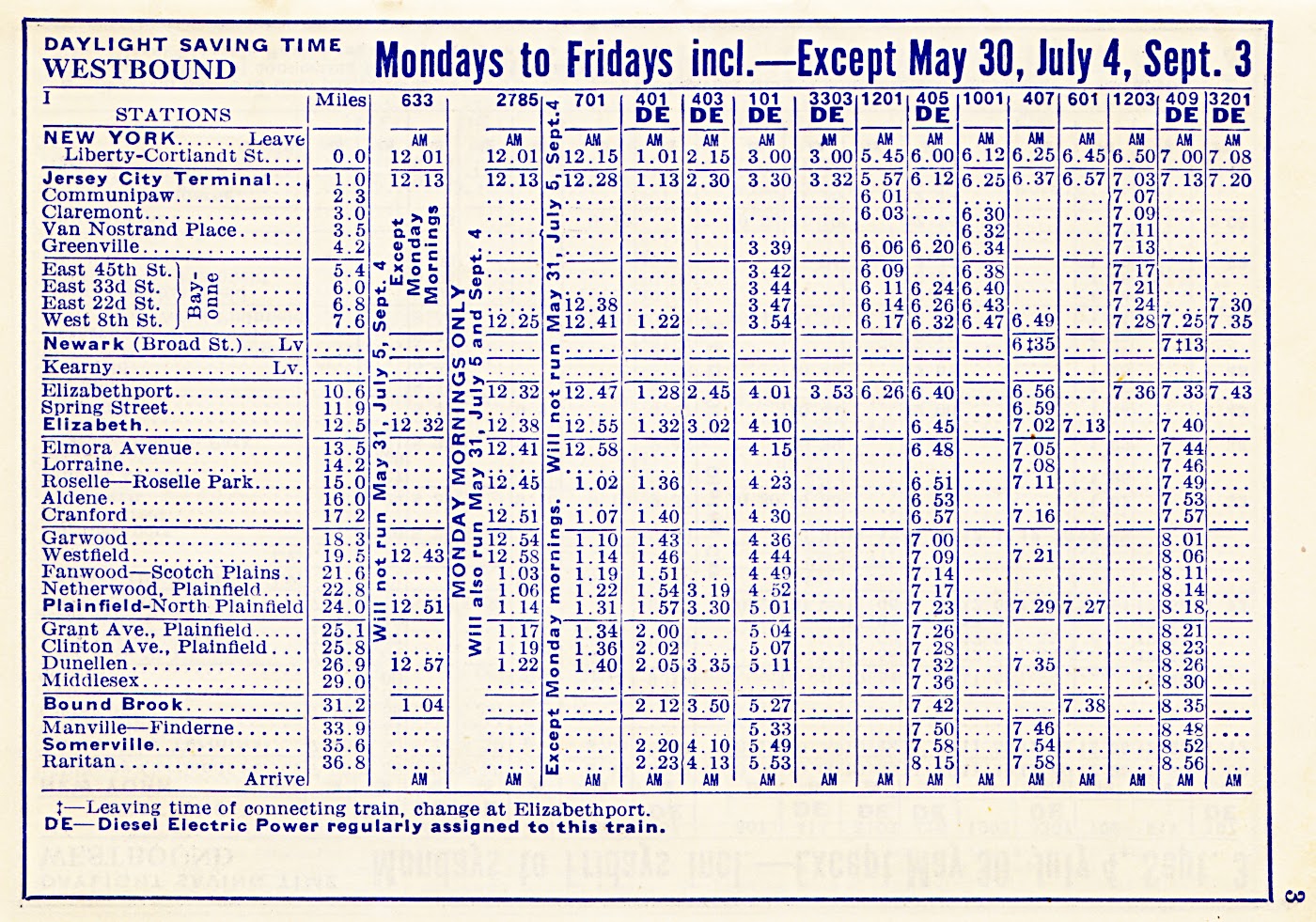Notice the double-ended Baldwin 'babyface' unit on the cover.
The Big Little Railroad occupied a particular economic niche in transporting suburban New Jersey commuters to Manhattan by rail and ferry. For many years, another profitable business of the CNJ was hauling anthracite coal.
As these two lines of business became increasingly obsolete in the 1950s, the railroad suffered ... from its lack of 'bridge traffic' income ... from the stranded capital in its obsolete coal-powered commuter motive power and coaches ... and from the extensive physical plant it maintained in urban settings.
* * *
The map below shows good station detail for most of the important Jersey Central lines. The Reading obtained control of the CNJ in 1901 ... and the B&O bought the Reading. The objective of the B&O was to get access to New York City via those other two lines.
The CNJ had some really large steam power for its freight business which included its traditional anthracite lines into Pennsylvania. A couple of photos are shown at the end of this post.
 |
| from: Official Guide, June 1941. |
* * *
The map below identifies all of the important commuter stations in the timetable.
 |
| from: Northeast Railroad Scene, Vol 5 The Jersey Central; Bob Pennisi; 1980; Railroad Avenue Enterprises. |
* * *
The old 1912 map, below, shows how CNJ's ferries connected the New Jersey commuters with Manhattan.
 |
| from: Industrial Review of New York; 1912; George F Cram. |
 |
| from: Jersey's Own Railroad; William R Frutchey; Trains, Dec 1946; Kalmbach. |
The camel-back locomotives were apparently designed to provide a large grate area for the slow-burning anthracite coal. This low-smoking hard coal was in high demand for urban space heating and substantial deposits were in production on the Pennsylvania end of the CNJ.
On the camel-backs, the engineer occupied the 'well-heated' cab which straddled the boiler and the fireman took his traditional place with his shovel at the backhead of the boiler where he could get a nice sun tan. This arrangement was tolerable for commuter service, but it is hard to imagine engine crews happily working on these engines in the 1940s.
On the excellent public relations video linked at the end of this post, there are only two very quick glimpses of these anachronistic locomotives shown.
This is the end of the Monday-Friday westbound timetable.
Saturday/Sunday westbounds are below.
* * *
 |
| from: Diesels from Eddystone; Gary & Stephen Dolzall; 1984; Kalmbach. |
On 6 November 1946, Baldwin and CNJ officials celebrated the delivery of a DR-6-4-20.
* * *
Here are the Monday to Friday eastbound timetables.
The Saturday and Sunday eastbounds are shown below.
Accounting for inflation ... a US dollar in 1951 equals about 32 US dollars in 2024.
This transfer was found between Pages 28 and 29 of this timetable.
* * *
 |
| from: Jersey's Own Railroad; William R Frutchey; Trains, Dec 1946; Kalmbach. |
Above: The eastern terminal of the CNJ, Reading and Baltimore & Ohio at Jersey City.
The engine in the photo is pushing a passenger consist into the stub-end terminal at the water's edge.
When I was preparing the image I had to double-check ...
yes, indeed, that is the Manhattan skyline beyond the signal bridge.
You know ... if everyone wasn't burning so much coal ...
* * *
 |
| from: Jersey's Own Railroad; William R Frutchey; Trains, Dec 1946; Kalmbach. |
Above: The service tracks outside the Jersey City roundhouse.
* * *
A very good 25-minute YouTube video ...
On YouTube I've watched many short railroad publicity films from the 1940s and 1950s. The film linked below is one of the most interesting ones I've seen. Above all, it maintains a brisk and energetic pace. It shows a great amount of railroad operating detail. There are a few unusual pieces of equipment and operations one doesn't often see in these videos.
- In keeping with its optimistic message, only two quick views of the old camel-back engines are shown.
- The Ashley Planes are shown in operation. This was an old-fashioned 14-degree (max) inclined-plane standard gauge branch (primarily for coal) ... powered by stationary engines and used until the late 1940s.
- A particular hopper car is shown being loaded from an enormous old anthracite pit and we see it a few times as we follow the line-narrative from Pennsylvania ... to the unloaders at the waterfront opposite New York City - where the same car is emptied.
- Two types of Baldwin 'babyface' units are shown being used in passenger service.
- A Jordan spreader is seen in action during ditching. And a large primitive Speno ballast cleaner operates as well.
- CNJ passenger ferry, car float and lighter operations are shown.
- A tender-top generator for commuter car interior lighting is seen.
- The original 'oil-electric' locomotive ... which had been working continuously on a Class 1 railroad since 1925 ... is seen in two views. This was the Alco/GE/IR boxcab used at the (fascinating, modeller's favourite) water-isolated 'Bronx Terminal'. A couple of short clips show it in operation. One source said that oil-electric was the preferred term in 1925 because the Germans had just been defeated in The War, and calling it a Diesel-electric after the motor's inventor would not have seemed appropriate.
- Bonus: You can hear Mauch Chunk and Wilkes-Barre pronounced by a professional!






















